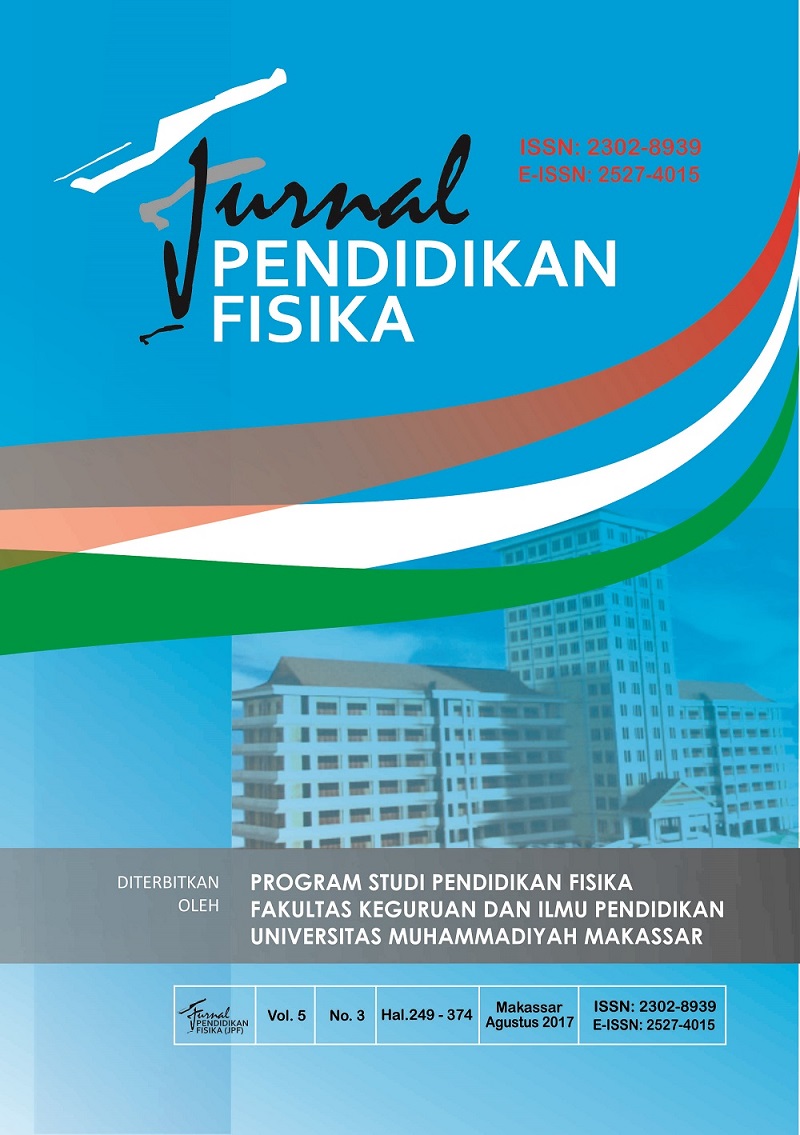Kemampuan Mengidentifikasi Variabel-Variabel Pada Fenomena Fisika Dalam Kehidupan Sehari-Hari Peserta Didik Kelas XII SMA Barrang Lompo
DOI:
https://doi.org/10.26618/jpf.v5i3.691Abstract
Masalah utama dalam penelitian ini yaitu bagaimana kemampuan mengidentifikasi variabel-variabel pada fenomena fisika dalam kehidupan sehari-hari peserta didik di kelas XII SMA Barrang Lompo. Penelitian ini bertujuan mendeskripsikan bagaimana kemampuan mengidentifikasi variabel-variabel pada fenomena fisika dalam kehidupan sehari-hari peserta didik di kelas XII SMA Barrang Lompo, semester ganjil tahun ajaran 2016/2017.Penelitian ini adalah penelitian Ex Post Facto yang bersifat deskriptif-survei. Subjek penelitian ini adalah peserta didik kelas XII SMA Barrang Lompo yang terdaftar pada tahun 2014/2015 dengan jumlah peserta didik 25 orang sebagai sampel penelitian. Untuk mengetahui skor rata-rata dan kategori kemampuan mengidentifikasi variabel-variabel peserta didik dapat dilihat dari hasil tes peserta didik yang disediakan. Teknik pengumpulan data yang dilakukan dalam penelitian ini adalah data mengenai kemampuan mengidentifikasi variabel-variabel pada fenomena fisika dalam kehidupan sehari-hari peserta didik. Pemberian skor yang diberikan menggunakan tes uraian. Data yang terkumpul diolah dengan menggunakan statistik deskriptif untuk memperoleh gambaran secara kuantitatif. Hasil penelitian ini menunjukkan bahwa skor rata-rata kemampuan mengidentifikasi variabel-variabel fisika peserta didik adalah 8,16 dari skor ideal yaitu 10. Dari hasil analisis, peserta didik berada pada kategori tinggi (84%) sebanyak 21 orang, sedangkan pada kategori sedang (12%) sebanyak 3 orang dan pada kategori rendah (4%) sebanyak 1 orang peserta didik. Berdasarkan hasil penelitian tersebut di atas, dapat disimpulkan bahwa kemampuan mengidentifikasi variabel-variabel fisika dapat dikatakan tinggi.
Kata kunci: Penelitian Ex Post Facto bersifat deskrpitif-survei, kemampuan mengidentifikasi variabel-variabel
The main problem in this research is how the ability to identify the variables of physical phenomena in the everyday life of students in class XII SMA Barrang Lompo. This study aims to describe how the ability to identify the variables of physical phenomena in the everyday life of students in class XII SMA Barrang Lompo, the first semester of the academic year 2016 / 2017.Penelitian is a research Ex Post Facto descriptive-survey. The subjects were students of class XII SMA Barrang Lompo registered in the year 2014/2015 by the number of learners 25 people as samples. To find the average score and category ability to identify variables that learners can be seen from the test results learners are provided. Data collection techniques used in this research is data on the ability to identify the variables of physical phenomena in the everyday lives of learners. Scoring is given using a test description. The data collected was processed using descriptive statistics to obtain a quantitative basis. The results of this study showed that the average score of the ability to identify variables physics students is 8.16 of an ideal score is 10. From the analysis, the students at the high category (84%) as many as 21 people, while in the medium category ( 12%) of 3 people and in lower categories (4%) of 1 learners. Based on these results above, it can be concluded that the ability to identify variables that physics can be said to be high.
Keywords: Ex Post Facto Research is deskrpitif-surveys, the ability to identify variablesReferences
Departemen Pendidikan Nasional. 2003. Undang-Undang Republik Indonesia Nomor 20 Tahun 2003 Tentang System Pendidikan Nasional.
Martawijaya, M. Agus. 2014. Model Pembelajaran Fisika Berbasis Kearifan Lokal Untuk Meningkatkan Karakter dan Ketuntasan Belajaran Peserta Didik SMP di Pulau Barrang Lompo. Disertasi. Program Pasca Sarjana Universitas Negeri Makassar. Makassar.
Nasution, S. 1986, Belajar dan Mengajar, Jakarta, Bina Aksara.
Ratna W, D. 1989. Teori-Teori Belajar, Jakarta, Erlangga
Usman. 1995. Menjadi Guru Yang Profesional: Remaja Rosdakarya. Bandung
Tirtahardja, U. 2005. Pengatar pendidikan. Jakarta: Penerbit Rineka Cipta.
Natsir, M. 2004. Strategi Belajar Fisika. Makassar: Program SP4 Tahun 2004 Jurusan Fisika Universitas Negeri Makassar.
Arsyad, Z. 2004. Media Pembelajaran. Jakarta: PT Raja Grafindo Perkasa.
Yuliani Nurani Sujiono. 2007. Metode Pengembangan Kognitif. Iakafia: Bandung. Universitas Terbuka.
Robbin dan Timonthy. 2009. Prilaku Organisasi. Yogyakarta : Amus
Kementrian Pendidikan Nasional. 1997. Kamus Lengkap Bahasa Indonesia. Jakarta: Kementrian Pendidikan Nasional.
Sugiyono. 2013. Statistika Untuk Penelitian. Bandung. Alfabeta
Anjarwati. 2009. Kamus besar bahasa indonesia.
http://www.artikata.com/arti-333239-kasus.html diakses pada tanggal 06 Juni 2016 pukul 15:40
(http://purrii.blogspot.co.id/ diakses pada tanggal 30 Juli 2016 pukul 01.50)
Arikunto, S. 2010, Dasar-dasar Evaluasi Pendidikan. Jakarta: PT Bumi Aksara
Downloads
Published
Issue
Section
License
Copyright:
Authors who publish with this journal agree to the following terms:
1. Authors retain copyright and grant the journal right of first publication with the work simultaneously licensed under a Creative Commons Attribution-ShareAlike 4.0 International License that allows others to share the work with an acknowledgement of the work's authorship and initial publication in this journal.
2. Authors are able to enter into separate, additional contractual arrangements for the non-exclusive distribution of the journal's published version of the work (e.g., post it to an institutional repository or publish it in a book), with an acknowledgement of its initial publication in this journal.
3. Authors are permitted and encouraged to post their work online (e.g., in institutional repositories or on their website) prior to and during the submission process, as it can lead to productive exchanges, as well as earlier and greater citation of published work.
Licence:
Authors are free to:
1. Share: Copy and redistribute the material in any medium or format
2. Adapt: Remix, transform, and build upon the material for any purpose, even commercially.
The licensor cannot revoke these freedoms as long as the authors follow the license terms, which include the following:
1. Attribution: You must give appropriate credit, provide a link to the license, and indicate if changes were made. You may do so in any reasonable manner, but not in any way that suggests the licensor endorses you or your use.
2. ShareAlike: If you remix, transform, or build upon the material, you must distribute your contributions under the same license as the original.
3. No additional restrictions: You may not apply legal terms or technological measures that legally restrict others from doing anything the license permits.
Jurnal Pendidikan Fisika is licensed under a Creative Commons Attribution-ShareAlike 4.0 International License.

